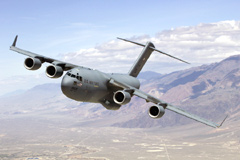
| Edwards Welcomes
Back the Air Force's First C-17 |
|
|
3/22/2007 - EDWARDS AFB, CA -- The C-17 Globemaster III Integrated Test Force welcomed home Edwards' own C-17, called T-1, during a celebration at hangar 1623 here March 16. T-1 first came to Edwards on Sept. 15, 1991, as the Air Force's first test article for the C-17's initial flight testing. "The significance of T-1 is it was the first C-17 built," said Lt. Col. Robert Poremski, C-17 Integrated Test Force director. "It was not built to be an operational flying cargo plane. It was built for one reason -- to come to Edwards and perform developmental testing. The aircraft was hand-built, which is different from a production aircraft. This was a labor of people and good old fashioned sheet metal workers." After nearly 16 years, T-1 has compiled 3,063 flight hours; 2,306 ground hours; 14,120 test points; and 1,403 tests. With the aircraft being hand-built, T-1 was supposed to last for only five years during initial developmental testing for the C-17 systems. "During that time, people realized how incredibly useful T-1 is to keep it flying," Colonel Poremski said. After the initial five years, T-1 was inspected, and it was decided that it could perform test functions until 3,000 flight hours, he said. The Air Vehicle Group, stationed at Wright-Patterson Air Force Base, Ohio, performed an analysis of the costs between getting a new C-17 with the instrumentation, and giving up T-1 and its capabilities; or bringing T-1 in for major modifications to strengthen areas, rework the aircraft and upgrade the extension to 15 years as a flight test aircraft. But after 15 years, T-1 is still not retiring as it was modified again to last for 15 more years. Prior to its arrival here, the aircraft was in San Antonio for life extension inspections and modifications, said Roy Smith, C-17 Boeing Integrated Test Force director. The aircraft underwent an entire structural integrity upgrade, said 1st Lt. Ryan Marvin, C-17 project manager. It is almost a new aircraft. The aircraft is now capable of executing tests until it reaches 7,500 flight hours. "The T-1 aircraft is the key to test and evaluation here to support the warfighter," Lieutenant Marvin said. "The 516th Aeronautical Systems Group has testing planned out through 2015. With this planned, it was decided through coordination between the (418th Flight Test Squadron C-17 Test Team) and 516th AESG with inputs and needs from Air Mobility Command leading AESG to make the decision for T-1 life extension." It was determined it is more beneficial and economically feasible to the Air Force to continue using T-1 than pulling a production aircraft out of the C-17 fleet, he said. It would cost roughly $220 million to completely acquire and instrument a new aircraft to a T-1 equivalent configuration. "When a test comes to Edwards for the C-17, the first question they would ask is 'can we do it on T-1,'" Colonel Poremski said. "It is the preferred aircraft to do a follow-on flight test on C-17s." The aircraft is scheduled to perform flight testing to include airdrop improvements and core-computer replacement testing. Because of the data systems already installed, the test team here is going to replace the core computer on the C-17, Colonel Poremski said. They plan to do it on T-1 because it has the capability to swap between old and new software. "T-1 is sentimental for us," Lieutenant Marvin said. "It is our baby. It is the only C-17 we own. Every other C-17 tested here is borrowed from Air Mobility Command. Coming back here meant a lot for many people. We didn't think it would come back, but I'm glad we finally have T-1 home." Source: USAF Edwards AFB Press Release by Airman 1st Class Julius Delos Reyes |
| |
